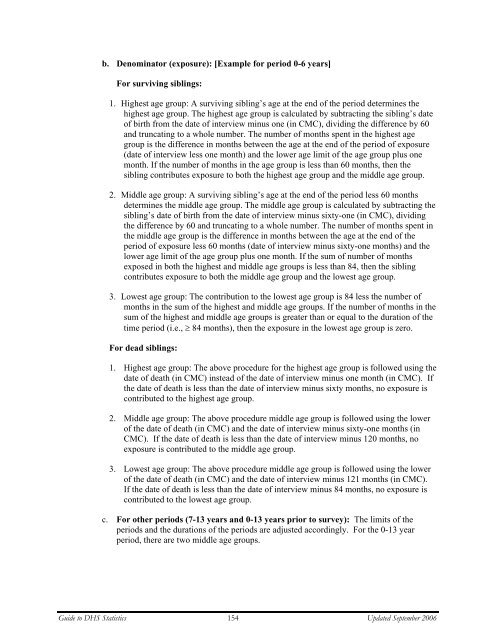Demographic and Health Surveys Methodology - Measure DHS
Demographic and Health Surveys Methodology - Measure DHS
Demographic and Health Surveys Methodology - Measure DHS
Create successful ePaper yourself
Turn your PDF publications into a flip-book with our unique Google optimized e-Paper software.
. Denominator (exposure): [Example for period 0-6 years]For surviving siblings:1. Highest age group: A surviving sibling’s age at the end of the period determines thehighest age group. The highest age group is calculated by subtracting the sibling’s dateof birth from the date of interview minus one (in CMC), dividing the difference by 60<strong>and</strong> truncating to a whole number. The number of months spent in the highest agegroup is the difference in months between the age at the end of the period of exposure(date of interview less one month) <strong>and</strong> the lower age limit of the age group plus onemonth. If the number of months in the age group is less than 60 months, then thesibling contributes exposure to both the highest age group <strong>and</strong> the middle age group.2. Middle age group: A surviving sibling’s age at the end of the period less 60 monthsdetermines the middle age group. The middle age group is calculated by subtracting thesibling’s date of birth from the date of interview minus sixty-one (in CMC), dividingthe difference by 60 <strong>and</strong> truncating to a whole number. The number of months spent inthe middle age group is the difference in months between the age at the end of theperiod of exposure less 60 months (date of interview minus sixty-one months) <strong>and</strong> thelower age limit of the age group plus one month. If the sum of number of monthsexposed in both the highest <strong>and</strong> middle age groups is less than 84, then the siblingcontributes exposure to both the middle age group <strong>and</strong> the lowest age group.3. Lowest age group: The contribution to the lowest age group is 84 less the number ofmonths in the sum of the highest <strong>and</strong> middle age groups. If the number of months in thesum of the highest <strong>and</strong> middle age groups is greater than or equal to the duration of thetime period (i.e., 84 months), then the exposure in the lowest age group is zero.For dead siblings:1. Highest age group: The above procedure for the highest age group is followed using thedate of death (in CMC) instead of the date of interview minus one month (in CMC). Ifthe date of death is less than the date of interview minus sixty months, no exposure iscontributed to the highest age group.2. Middle age group: The above procedure middle age group is followed using the lowerof the date of death (in CMC) <strong>and</strong> the date of interview minus sixty-one months (inCMC). If the date of death is less than the date of interview minus 120 months, noexposure is contributed to the middle age group.3. Lowest age group: The above procedure middle age group is followed using the lowerof the date of death (in CMC) <strong>and</strong> the date of interview minus 121 months (in CMC).If the date of death is less than the date of interview minus 84 months, no exposure iscontributed to the lowest age group.c. For other periods (7-13 years <strong>and</strong> 0-13 years prior to survey): The limits of theperiods <strong>and</strong> the durations of the periods are adjusted accordingly. For the 0-13 yearperiod, there are two middle age groups.Guide to <strong>DHS</strong> Statistics 154 Updated September 2006








![Obtaining Informed Consent for HIV Testing [QRS4] - Measure DHS](https://img.yumpu.com/49850117/1/190x245/obtaining-informed-consent-for-hiv-testing-qrs4-measure-dhs.jpg?quality=85)







